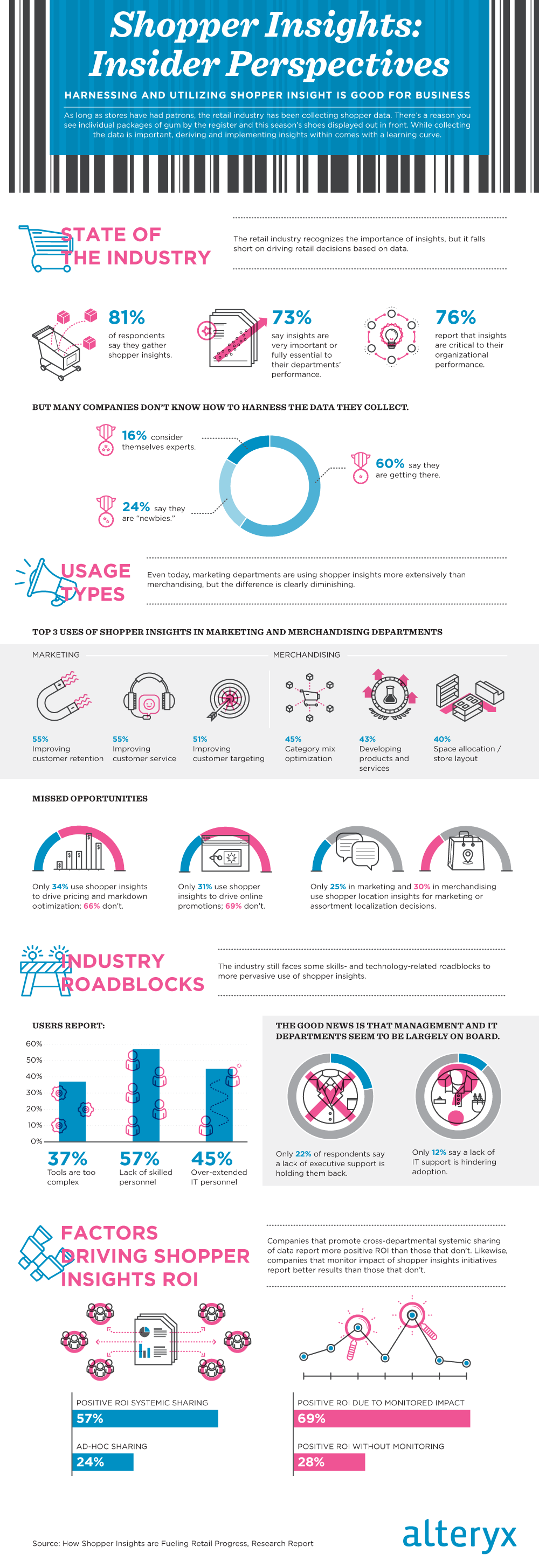“In the history of advertising,” writes Steve Sachs (@stevenmsachs), CEO of OneSpot, “no consumer turns on their digital device and seeks out display ads to engage with a brand. What they’re almost always looking for is great content. That’s the core appeal of content marketing: Businesses and brands can speak to their target customers where those customers are already engaged.” [“Why marketers need a more data-driven approach to content marketing,” iMedia Connection, 28 July 2014] Discovering what is of interest to consumers and then providing them with appropriate ads are the two principal activities of targeted marketing. Manufacturers and retailers are beginning to understand how important big data analytics can be for helping them understand what interests their customers. Virginia Backaitis (@actbrilliant) reports, “A recent survey, conducted by RetailWire and commissioned by big data analytics provider Alteryx, reveals that 73 percent of retailers consider shopper insights to be very important or essential to the performance of the departments in which they work. In addition, 76 percent think leveraging shopper insights is important to the performance of the company as a whole.” [“Big Data is Here: How About Actionable Insights?” CMS Wire, 5 August 2014] Other insights from the survey are found in the following infographic that Backaitis included in her article.

Backaitis notes, “Only 16 percent of the 350 retailers and brand manufacturers surveyed consider themselves to be ‘experts’ in deriving shopper insights from their data and using it to drive retail decisions. That’s an expensive knowledge gap.” I agree. As the founder, President, and CEO of Enterra Solutions®, a cognitive computing company that offers big data solutions, I know that help is available to close that gap. Backaitis notes that only the largest companies can afford to hire data scientists who can help them mine mountains of data for actionable insights. That’s why Enterra’s solutions contain embedded expertise that make them user friendly and free companies from having to hire experts to help them perform big data analytics.
Amit Deshpande, a senior director at Epsilon, notes that one of the greatest benefits of big data analytics for marketers is the ability to finely tune segmentation efforts. “Big Data is like the population in some emerging countries,” he writes. “There is a lot of it (volume). It’s incredibly diverse (variety). And it’s growing at an extremely rapid rate (velocity).” [“Get Insight That’s Actionable,” Direct Marketing News, 1 March 2013] He continues:
“This has created unprecedented economic opportunity for businesses. History has proven that businesses often don’t move at the speed recommended by pundits to take full advantage of these kinds of opportunities. Now, with Big Data-enabled improvements in analytics, including segmentation, organizations can realize the financial benefits and evolve along the Big Data journey. For years, segmentation has been fundamental to engaging customers and achieving superior financial performance. Traditional schemes have relied on demographic, firmographic, survey response, and customer behavior data. The emergence of Big Data has created tremendous variety and timeliness of customer information. Thus, segmentation can now unearth greater customer insight. The Big Data-enabled possibilities are enormous.”
In a previous article entitled “The Growing Importance of Mobile Tech on the Digital Path to Purchase,” I noted that mobile technologies are beginning to dominate consumers’ digital path to purchase. Dr. Olly Downs (@mathandporsches), a Senior Vice President of data sciences at Globys, notes, “Successful mobile marketing is all about 1:1 customer engagement — delivering a relevant message to an individual customer in the right context — with the goal of delighting the customer.” [“Machine Learning and What It’s Doing for Mobile Marketing,” Direct Marketing News, 4 June 2013] He adds:
“But how do you determine the best way to engage with each customer — especially when you have thousands or even millions of customers? Is it possible to understand what’s ‘right’ for each individual when behaviors, such as shopping patterns, location, purchases, activity, usage, and social interactions are constantly changing? This requires a shift in marketing techniques and technologies. Customers aren’t satisfied with what’s deemed ‘good’ for the majority — they want what’s great for them. The challenge of delivering a personalized experience has ignited a search for marketing technologies that involve complex data capture, sophisticated analysis, and real-time decisioning to determine the best context for engaging each customer and the most relevant message — whether it be promotional, educational, informative, etc. … This is where machine learning comes into play. Machine learning has the ability to automatically improve with experience. Rather than being programmed by their users to solve a specific task or problem, computers come up with their own programs that become more intelligent over time as a result of the input that they are fed.”
Machine learning plays a substantial role in Enterra Solution’s Cognitive Reasoning Platform™ (CRP), a system that uses both reasoning and computation to achieve insights. Downs notes, “By using technology to target relevant offers in the right context to each customer, mobile operators, for example, are seeing a more than 10% improvement in customer revenues and retention.” The staff at Marketing Aces reminds us, “Marketers live in a world that is creating 2.5 exabytes of data each and every day. This provides both a challenge and an opportunity to marketers.” [“The top four applications of Big Data in marketing,” 5 August 2014] In a world in which so much data is being created, marketers simply can’t function effectively if they don’t take advantage of big data analytics. As the headline of the Marketing Aces’ article declares, the staff offers “the top four areas where big data benefits marketers.” They are:
1. Improved forecasting and planning — Marketers have always relied on forecasting to understand how individual marketing tactics deliver success. Big data enables marketers to increase the volume and range of information sources while speeding up reporting, enabling real-time forecasting and more informed decision-making. This means marketers can see how returns can be increased with extra budget, understand how different levels of spend affect revenue, and ascertain the potential of particular campaigns. … By using powerful algorithms that anticipate and react to changing conditions or models that cluster data points together based on similarity, marketers can improve forecasting accuracy across their operations.
2. More granular audience targeting — Marketers benefit from a huge amount of targeting options when it comes to online advertising. The growth of cookies and information-rich social media, means that the data is there to go beyond simple demographic, geographic, and time-based targeting options. Being able to tap into this information at scale through big data programs unlocks the ability for much more intelligent targeting. … A lot of companies are looking at ways of measuring cross-channel behavior, making it easier in the future to integrate campaigns across offline and online.
3. Optimizing campaigns in real-time — Understanding current performance enables marketers to optimize their campaigns and improve results in real-time. While it is potentially possible for humans to look at performance data, analyze it and make optimization decisions, big data adds a huge number of additional variables that are difficult for our brains to compute. Big data technology, such as algorithmic decisioning processes, can provide the sheer processing power needed to optimize campaigns in a scalable, real-time manner. …
4. Moving to multi-touch attribution — From the first web adverts, marketers have predominantly used the last-click model for conversion attribution, even though multiple factors tend to impact conversions. The problem was that previously capturing these different, interrelated factors and understanding their relative value was difficult. Big data changes this, by making it easier to track, analyse and evaluate activity across the consumer purchase life cycle. Consequently marketers can adopt a multi-touch approach which takes into account all touch-points.
The article concludes, “Big data promises to transform marketing as a discipline, providing the ability to better understand customers, in real-time, on a vast scale.” There has been a lot of hype and a lot of concern about big data in recent months. The fact remains, however, that data is going to continue to be generated, gathered, and analyzed. Manufacturers and retailers need to ensure that they are gleaning actionable insights from their data so that improved customer experiences result in an improved bottom line.




